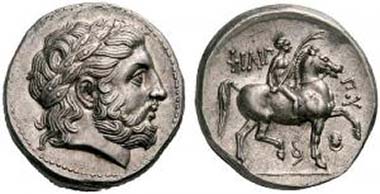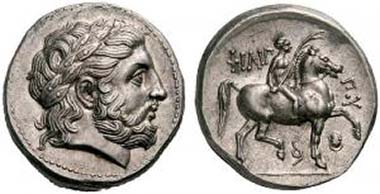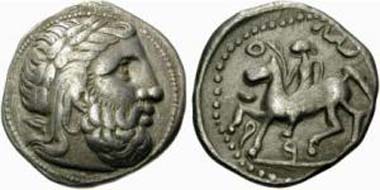November 22, 2010 – The dove should not be a symbol of peace, because it is a cruel animal, Pablo Picasso (1881—1973) once declared. The painter and artist Picasso is a person of great importance in modern art and public life, and during May 17th to September 5th 2010 the Picasso Museum in Malaga, Spain, had a theme exhibition on Picasso’s varied pictures of horses. An animal he took much more artistic pleasure in than the dove.
In ancient numismatic art the horse has been favored too. In fact it has been the motif par excellence. Several mints in the Mediterranean area made horse portraits on level with the best artists in modern times. Especially the Syracusian dekadrachm with its quadriga is a good example.
Lanz Sale 148 (2010), 23.
Though I think that, in a financial and trade context, the horse illustrating tetradrachm from Philip II was much more relevant in its age. Philip II (382-336 BC) was king of Macedonia and father of the well known king Alexander the Great. His coins, which are illustrating a horse on reverse and the thunder god Zeus on front, are found in big numbers during archaeological excavations. In addition, the Philip-tetradrachms are plentiful in coin auctions worldwide.
Rauch Mail Bid Sale 8 (2004), 30.
Philip’s coins were important currency and were soon imitated by next-door Celtic cultures. The imitations weigh less than the original Macedonian tetradrachms and the portraits are abstract bearing in mind the naturalistic coin motifs from king Philip. This was probably not a Celtic attempt to get into the Macedonian market taking into consideration weigh difference between Macedonian and Celtic coin imitations. The Celts were impressed by the Macedonian tetradrachms for one or another artistic reason.
Some of Philip’s tetradrachms are reaching high prices, but in the average most collectors should be able to acquire a Philip coin to their collections. Though, the purchaser is running a risk of buying a quite standard coin. The imitation collector is, on the other side, a buyer who risks doing a bargain. On some of the coins the abstracted horse motifs are bearing the artistic skill, which we can see in Picasso’s paintings. Other coins look a bit sloppier done. Nevertheless, the Celts’ lack of independence in choosing motifs was clearly outweighed by their artistic skills in abstract art, in a modern western interpretation context.
By: Marius Ringsrud, fil.mag.






